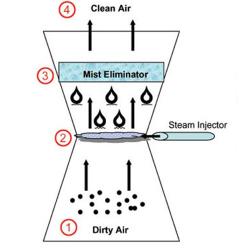Source Institutions
Add to list Go to activity
Activity link broken? See if it's at the internet archive

Learners observe and discuss a simple model of a wet scrubber, a device for cleaning industrial air pollution. This demonstration can be combined with other demonstrations and activities to create a larger lesson. Resource contains suggestions for assessment, extensions, and scaling for different levels of learners.
- 30 to 45 minutes
- 10 to 30 minutes
- $10 - $20 per group of students
- Ages 8 - 14
- Activity, Demonstration
- English
Quick Guide
Materials List (per group of students)
- Duct tape
- 1/2 cup chalk dust or fireplace ash
- 3 clear, glass bottles (such as large olive oil or liquor bottles)
- 3 rubber corks with 2 holes drilled in each (the corks must fit snuggly into the bottle openings; available at hardware stores, sometimes predrilled)
- 5 barb connectors (to connect plastic tubing to corks; the connector must fit snuggly into the holes in the corks; available at hardware stores; see Figure 3)
- 5 ft. clear plastic tubing (the tubing must fit snuggly over the barb connectors; available at hardware stores; see Figure 3)
- Various pipe connectors, as needed, to transition the narrow tubing to the wider vacuum cleaner nozzle (see Figure 2)
- Water
- Paper towels
- Wet/dry shop vacuum cleaner
Subjects
-
Earth and Space Science
-
Earth Structure
- Atmosphere
-
Earth Structure
-
Engineering and Technology
-
Engineering
- Civil Engineering
- Environmental Engineering
-
Engineering
-
Life Sciences
-
Ecology
- Human Impact
-
Ecology
-
The Nature of Technology
-
Technology and Society
- Technology and the Environment
-
Technology and Society
Audience
To use this activity, learners need to:
- see
Learning styles supported:
- Involves hands-on or lab activities
Other
Components that are part of this resource:
Includes alignment to state and/or national standards:
This resource is part of:
Access Rights:
- Free access
By:
- Kolenbrander, Amy ; Yowell, Janet ; Mach, Natalie ; Schaefer Zarske, Malinda ; Carlson, Denise ; Perez, Sharon
Source Collection
- TeachEngineering
Rights:
- All rights reserved, Regents of the University of Colorado, 2004
Funding Sources:
- Fund for the Improvement of Postsecondary Education (FIPSE)
- U.S. Department of Education
- National Science Foundation, 0226322
